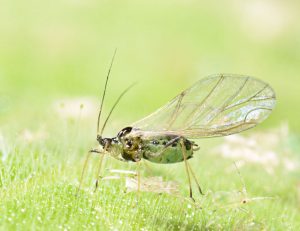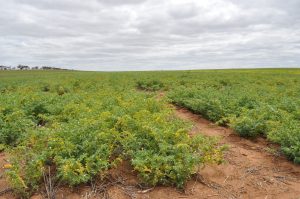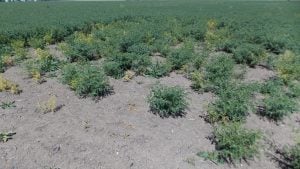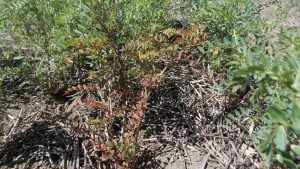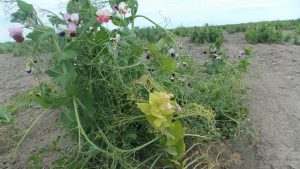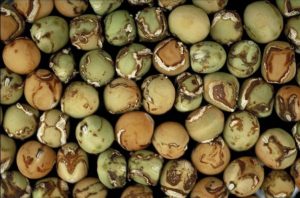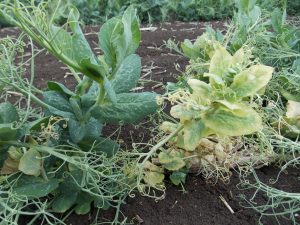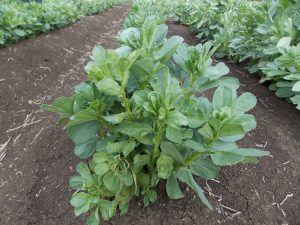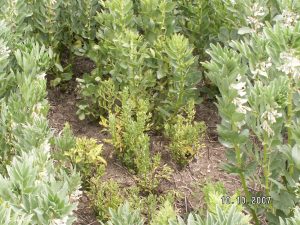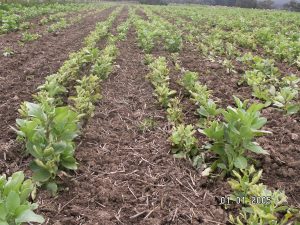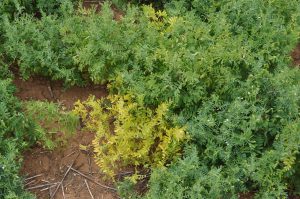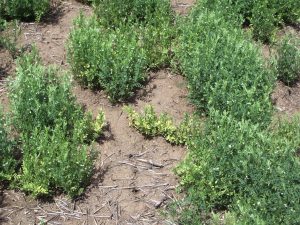The pulse viruses commonly found in Australia are Alfalfa mosaic virus, Bean yellow mosaic virus, Cucumber mosaic virus, Pea seed-borne mosaic virus, Bean leafroll virus, Turnip yellows virus, Soybean dwarf virus and Subterranean clover stunt virus.
Seed-borne pulse viruses and their pulse hosts
| Host Crop | Alfalfa mosaic virus (AMV) | Bean yellow mosaic virus (BYMV) | Cucumber mosaic virus (CMV) | Pea seed-borne mosaic virus (PsBMV) |
|---|---|---|---|---|
| Chickpea | X | X | X | X |
| Faba bean | * | X | X | X |
| Field pea | X | X | X | X |
| Lentil | X | X | X | X |
| Vetch | X | X | X | X |
| Narbon bean | * | * | X | X |
| Lathyrus | X | * | * | X |
| Lupins - L. angustifolius | X | * | X | N/A |
* plants may be infected but virus is not seed-borne
Common persistent viruses of temperate pulses
| Host Crop | Bean leaf roll virus (BLRV) | Turnip yellows virus (TuYV) | Subterranean clover stunt virus (SCSV) |
|---|---|---|---|
| Chickpea | * | * | |
| Faba bean | * | * | * |
| Field pea | * | * | * |
| Lentil | * | * | * |
| Vetch | * | ||
| Narbon Bean | * | * | * |
| Lathyrus | * | * | |
| Lupins - L. angustifolius | * | * |
AMV, BYMV, CMV and PSbMV are seed-borne, mechanically transmissible or transmitted by aphids in a non-persistent way (aphid feeds on a plant for a few minutes to hours, then the virus is lost from the mouth parts). BLRV, TuYV, SbDV and SCSV are phloem-limited and only transmitted by aphids in a persistent way (the virus stays in the aphid vector for life).
A number of factors interact to determine whether or not a particular year is conducive to virus spread. The main factors which influence virus spread are those that affect the aphid population (such as the weather) and the availability of sources of virus for the aphids to spread (seed, weeds, pasture hosts, etc.).
What to Look For
A number of factors may affect the development of symptoms in the field including the cultivar, infection (seed-borne or during growing season) and other stresses. In some situations, there may be no apparent symptoms on infected plants whereas in other situations, stress symptoms in healthy plants may be mistaken for virus symptoms.
The common aphid vectors of pulse viruses in western Victoria are the green peach aphid (Myzus persicae) , blue green lucerne aphid (Acyrthosiphon kondoi), spotted alfalfa aphid (Therioaphis trifolii forma maculate), potato aphid (Macrosiphum euphorbiae) and leaf-curling plum aphid (Brachycaudus helichrysi).
Chickpea – What to Look For
Alfalfa mosaic virus (AMV): Desi chickpeas show shoot tip necrosis combined with chlorosis and reddening of the leaf margin. Kabuli chickpeas show yellowing and necrosis of tips and stunting of plants.
Cucumber mosaic virus (CMV): Desi chickpeas show chlorosis, reddening and stunting of plants and Kabuli chickpeas show chlorosis and yellowing of leaves and stunting of plants.
Bean yellow mosaic virus (BYMV): Desi chickpeas show apical necrosis and reddening, plant stunting and premature senescence. Kabuli chickpeas show apical necrosis and chlorosis and plant stunting and premature senescence.
Pea seed-borne mosaic virus (PSbMV): Chlorosis on new shoots, mottling of leaves, down curling of leaves and plant stunting.
Turnip yellows virus (TuYV): Chlorosis and yellowing of whole plant and stunting in Kabuli chickpea and purple leaves in Desi chickpea. Early infected plants often die.
TuYV symptoms in kabuli chickpea
Field Pea -What to Look For
Alfalfa mosaic virus (AMV): Chlorosis in new shoots, necrotic spots on leaves and streaking, necrosis of new or old leaves.
Cucumber mosaic virus (CMV): Chlorosis and yellow tips.
Bean yellow mosaic virus (BYMV): In some cases the virus may be symptomless or there can be mosaic symptoms, leaf deformation, severe stunting of the plant and premature senescence.
Pea seed-borne mosaic virus (PSbMV): In some cases the virus may show no symptoms or there may be downward curling of leaves and mild to severe plant stunting. The infected plants may produce seeds having brown marks or ringspots.
Turnip yellows virus (TuYV): Stunting and yellowing of plants.
Faba Bean – What to Look For
Alfalfa mosaic virus (AMV): Chlorosis in new shoots, leaf rolling, red ringspots on leaves and plant stunting.
Cucumber mosaic virus (CMV): Symptoms are variable and range from no symptoms to systemic necrosis to plant death.
Bean yellow mosaic virus (BYMV): Mosaic, dark green islands, vein banding.
Pea seed-borne mosaic virus (PSbMV): Mosaic, vein banding, dark green islands.
Bean leafroll virus (BLRV): Rolling of leaves inwards with thick and leathery leaves and stunting of the plant.
Subterranean clover stunt virus (SCSV): Infected bean plants remain very stunted and yellowish.
Lentil – What to Look For
Alfalfa mosaic virus (AMV): Necrosis on tip growth, twisting and deformation of leaves.
Cucumber mosaic virus (CMV): Chlorosis, yellowing and stunting of plants.
Bean yellow mosaic virus (BYMV): Chlorosis, leaf malformation and stunting of plants.
Pea Seed-borne mosaic virus (PSbMV): No symptoms or there may be chlorosis in new shoots, mottling on leaves, shoot tip necrosis and stunting of plants.
Turnip yellows virus (TuYV): stunting and yellowing of plants.
Lupin – What to Look For
Alfalfa mosaic virus (AMV): The symptoms are tip necrosis, yellow leaves and mild stunting.
Cucumber mosaic virus (CMV): Reduced internodes, bunchy appearance and plant stunting. If the virus is carried in the seed the entire plant will be stunted and may die before maturity. A plant infected late in the season may have normal sized leaves at the bottom but those near the top, above the point of infection, will be less than half the normal size. The leaves on infected plants become bunched, curled down and chlorotic (pale in colour), particularly at the growing shoots. Infected plants may occur randomly throughout the paddocks. Often they will be in small patches, 1-2 metres in diameter.
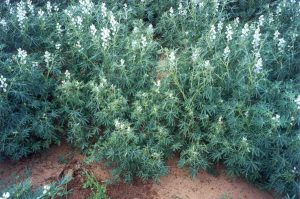
Stunting and bunching symptoms of CMV in narrow leaf lupins (front plants) surrounded by healthy plants
Bean yellow mosaic virus (BYMV): The initial symptoms are yellowing of leaves followed by necrosis of growth tips and death of plant. The late infection may cause black pod symptoms. BYMV is a serious disease in narrow leafed lupins. Two strains of the virus occur in Western Australia. These are differentiated by symptoms in narrow-leafed lupin: the common necrotic (BYMV-N) strain kills the infected plant, and the less abundant non-necrotic (BYMV-NN) strain causes stunting without killing the plant. All BYMV strains which are endemic in Australia are not seedborne in lupins, unlike overseas strains.
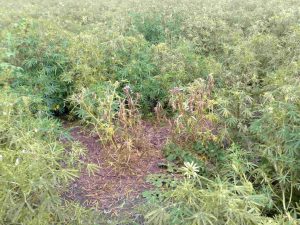
Symptoms of BYMV in narrow leaf lupin. The initial symptoms are yellowing of leaves, followed by necrosis of growth tips and death of plants.
Management of Pulse Viruses
- Growing virus resistant varieties is the long term best option, but the number of resistant varieties is limited. Breeding is underway to develop a faba bean with BLRV resistance and field pea with PSbMV and BLRV resistance.
- Sowing virus tested seed which has a virus level less than 0.1-0.5 per cent is an effective way to control seed-borne viruses which can only be spread short distances in the field by their aphid vectors (non-persistent transmission).
- Eliminating weeds and self-sown pulses. These are a source of virus and aphids and this is usually where they survive between crop growing seasons.
- Monitoring aphids, particularly at the early growth stages of the crop. If aphids develop heavy colonies at this early stage, then it may be economical to spray the crop with an aphicide.
- Good plant stands with minimal bare ground will reduce aphid colonisation.
- Rotation of pulses with cereals and reduce self-sown hosts and weeds.
- Removal of plants with symptoms will reduce the amount of infected seed harvested (appropriate for some seed crops). The amount of virus infection in the harvested seed (per cent) depends not only on the number of infected plants, but also on the rate of seed transmission of the virus.
- Seed treatment with neonicotinoid (e.g. imidacloprid) insecticide reduces aphid feeding and virus spread. It is especially beneficial for persistently transmitted viruses.

